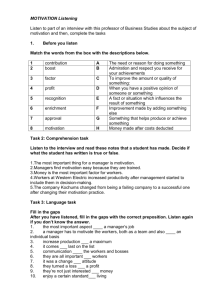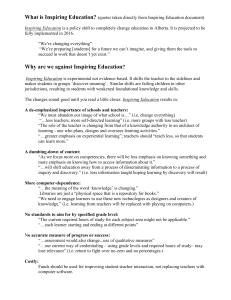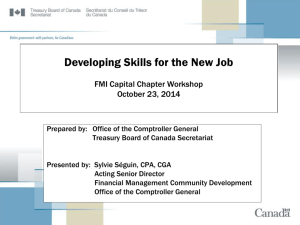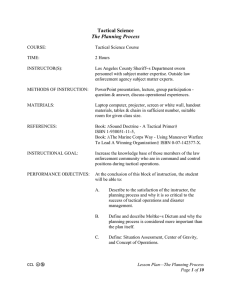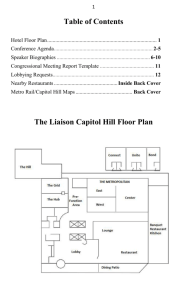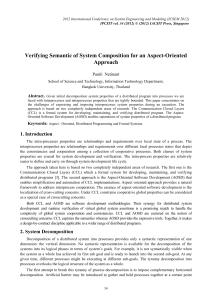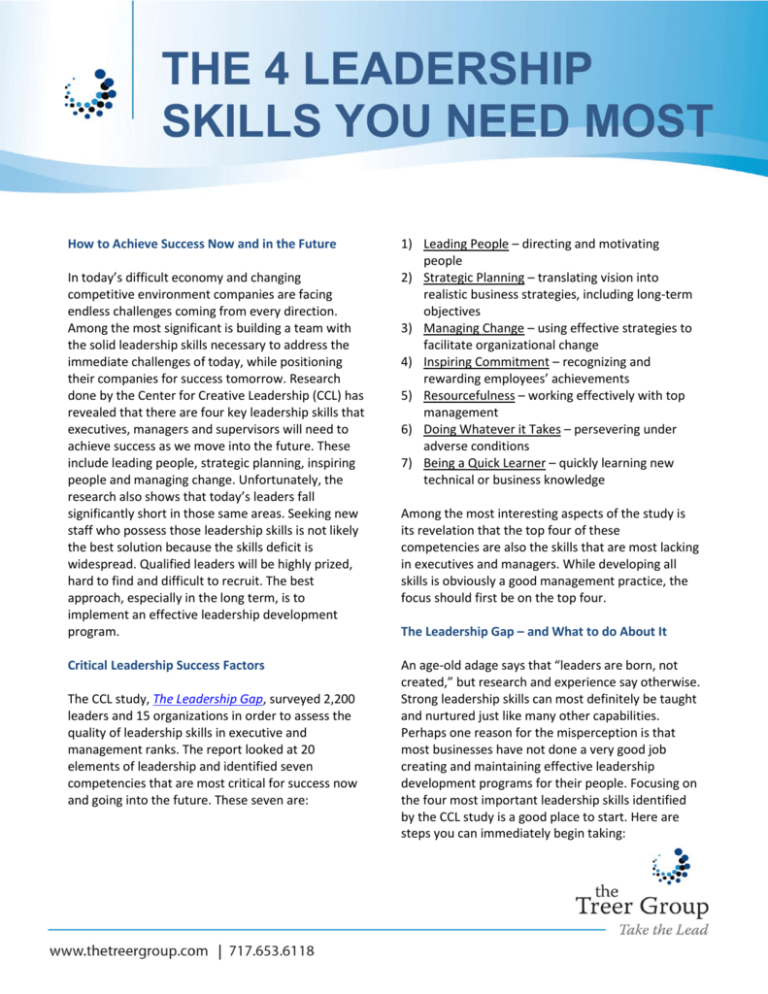
THE 4 LEADERSHIP
SKILLS YOU NEED MOST
How to Achieve Success Now and in the Future
In today’s difficult economy and changing
competitive environment companies are facing
endless challenges coming from every direction.
Among the most significant is building a team with
the solid leadership skills necessary to address the
immediate challenges of today, while positioning
their companies for success tomorrow. Research
done by the Center for Creative Leadership (CCL) has
revealed that there are four key leadership skills that
executives, managers and supervisors will need to
achieve success as we move into the future. These
include leading people, strategic planning, inspiring
people and managing change. Unfortunately, the
research also shows that today’s leaders fall
significantly short in those same areas. Seeking new
staff who possess those leadership skills is not likely
the best solution because the skills deficit is
widespread. Qualified leaders will be highly prized,
hard to find and difficult to recruit. The best
approach, especially in the long term, is to
implement an effective leadership development
program.
Critical Leadership Success Factors
The CCL study, The Leadership Gap, surveyed 2,200
leaders and 15 organizations in order to assess the
quality of leadership skills in executive and
management ranks. The report looked at 20
elements of leadership and identified seven
competencies that are most critical for success now
and going into the future. These seven are:
1) Leading People – directing and motivating
people
2) Strategic Planning – translating vision into
realistic business strategies, including long-term
objectives
3) Managing Change – using effective strategies to
facilitate organizational change
4) Inspiring Commitment – recognizing and
rewarding employees’ achievements
5) Resourcefulness – working effectively with top
management
6) Doing Whatever it Takes – persevering under
adverse conditions
7) Being a Quick Learner – quickly learning new
technical or business knowledge
Among the most interesting aspects of the study is
its revelation that the top four of these
competencies are also the skills that are most lacking
in executives and managers. While developing all
skills is obviously a good management practice, the
focus should first be on the top four.
The Leadership Gap – and What to do About It
An age-old adage says that “leaders are born, not
created,” but research and experience say otherwise.
Strong leadership skills can most definitely be taught
and nurtured just like many other capabilities.
Perhaps one reason for the misperception is that
most businesses have not done a very good job
creating and maintaining effective leadership
development programs for their people. Focusing on
the four most important leadership skills identified
by the CCL study is a good place to start. Here are
steps you can immediately begin taking:
Leading People
The ability to effectively direct and motivate people
is a vital leadership skill that requires an executive or
manager to properly interact with staff. To be
successful they must delegate well, treat people
fairly, provide development opportunities for
employees, recruit talented people and more. Here
are ways to develop these skills:
Make sure that leaders understand and apply
sound management skills and exhibit behaviors
consistent with established best practices.
Assess the leadership skill levels for all
management staff. Carefully select assessment
tools that are appropriate and validated – such
tools are available from management consulting
firms.
Once gaps in skills are identified, create or obtain
development programs to build the skills your
management staff need.
Develop mentoring programs for your people.
Train management staff to foster an open and
honest environment where giving feedback can
occur on a regular basis.
Strategic Planning
Turning a big, long-term vision into tangible business
strategies is an essential management skill for
leading companies from the present to the future.
This skill can be developed in organizations by:
Creating a strong vision that leads an
organization toward a positive future.
Sharing that vision with all staff, clearly saying
where you are going and how you plan to get
there.
Developing your staff’s skills in strategic
planning, change management and execution.
Involving both seasoned and up-and-coming
staff members in your planning to gain a variety
of different perspectives and foster buy-in across
the organization.
Creating a versatile, well-rounded management
team through development programs that
expose staff to a variety of departments, skills
and perspectives.
Encouraging learning through mentoring and
developmental opportunities.
Inspiring Commitment
Managers can foster loyalty and commitment by
knowing what motivates their people and taking
appropriate action for each individual – rewards,
recognition, communications and other activities.
Build these skills by:
Recognizing and rewarding employees.
Sharing a clear vision and connecting it to each
employee’s role.
Expecting high standards from everyone.
Recognizing, rewarding and celebrating
successes.
Managing Change
The rapid pace of change has become an ongoing
business challenge. To effectively lead their
organizations into the future, managers need to
understand the dynamics of change, know who
embraces and who resists change and possess the
skills to inspire and motivate performance that
positively leverages change. Develop those skills by:
Involving your staff in planning, decision-making
and implementing change initiatives.
Providing, classes, training, forums and other
resources that help staff manage change.
Understanding that resistance to change that is
commonly based in fear and/or mistrust can be
overcome by regularly sharing information and
providing frequent opportunities for discussion.
Begin With Yourself
Successful leadership requires authenticity. Your
staff and employees will be more inspired,
determined and dedicated if they feel your
commitment and belief in what you say. Start by:
Becoming self-aware and understanding your
strengths and weaknesses so that you can more
effectively manage through delegation and other
techniques.
Seeking timely feedback from coworkers, peers,
friends, family and coaches.
Aligning your business and leadership strategies
by making sure that your business plans and staff
development initiatives are in sync.
Conclusion
Effective leadership development is essential to the
success of any organization, large or small. Creating
and implementing a strong plan will elevate your
team’s skill level in the key performance areas
identified by the Center for Creative Leadership.
These are competencies that are essential for
success today and, perhaps most importantly, as you
lead your organization into the future. Assess your
current staff’s leadership skills, identify gaps
compared to what your organization needs and
implement a plan to close those gaps. Start now, and
you and your people will be positioned for success
tomorrow.
© Copyright The Treer Group, 2012. All rights reserved.

